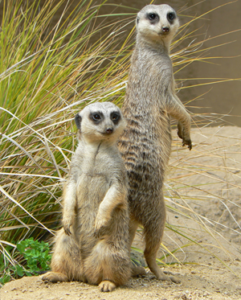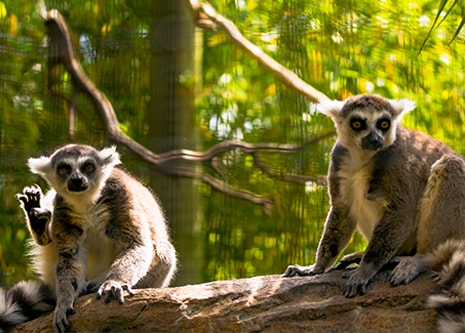
- VisitSupport Happy HollowDONATE TODAYExploreSupport Happy HollowDONATE TODAYLearnSupport Happy HollowDONATE TODAYSupport
-
Today's Hours: 10:00 am to 4:00 pm
Zoo in the HollowMeerkats

Scientific name: Suricata suricatta
Family: Herpestidae
Order: Carnivora
Class: Mammalia
Range: Botswana, Namibia, and South Africa
Habitat: Desert, grassland
Lifespan: 10 to 12 years in the wild; 12 to 15 years in captivity.What do they look like?
Meerkats are small animals, weighing one to two pounds. Their bodies are 17 to 21 inches long including their tail. Their fur is tan and grey with stripes running across their backs. The pattern of stripes across each meerkat’s back is unique to each individual. Meerkats have pointed faces with black eyes, ears, and noses. Their eyes face forward, providing binocular vision, and their ears can be closed to keep dirt out while digging. They have thin legs with long, strong non-retractable claws that are used to dig burrows, forage for food and climb trees or termite mounds.How do they behave?
Meerkats form cooperative groups of five to 30 members called “gangs,” “mobs,” or “clans.” These groups dig complex tunnel systems throughout their territory. These tunnel systems have separate underground dens for sleeping, rearing young, and even a bathroom! Meerkats are diurnal (mainly active during the daytime). They have great distance vision and the black patches of fur around their eyes cut down glare, allowing them to spot predators even when staring directly into the sun. Their impeccable sense of smell also allows them to locate food with ease. While the group is foraging, a sentry (lookout) is always on duty. The sentry will watch for predators while balancing on two legs and their tail, sounding a warning call if danger is spotted.What do they eat?
Meerkats eat mostly insects, but also feed on arachnids, millipedes, centipedes, snakes, lizards, small mammals, eggs, and plants. Because meerkats do not store much fat, they must forage for food daily. At Happy Hollow, they are fed insectivore diet, meat, insects, eggs, fruit and vegetables.How are they born?
An alpha pair presides over the gang, though others are still usually permitted to mate. Meerkats reach sexual maturity around one year of age. Gestation lasts approximately eleven weeks. Litters generally produce one to five pups, although three is most common. In the wild, a single female can have up to four litters per year. Pups are born with hair, but require parental care. At three weeks old, pups are permitted to leave the burrow. The event is accompanied by the rest of the group standing guard. Other meerkats often care for the alpha female’s young. Even females that have never had their own young may lactate to feed the alpha pair’s young.Conservation
Meerkats are common throughout their range in western and Southern Africa and their conservation status is listed by the International Union for Conservation of Nature as Least Concern. One organization dedicated to maintaining stable meerkat populations is the World Wildlife Fund. Their focus is on preserving vital habitat for meerkats and other grassland and desert species in Africa. Similarly, meerkats are part of a Species Survival Plan at accredited zoos throughout the country. The SSP ensures that zoos maintain a healthy population of meerkats within captivity, and contribute to their conservation in the wild. If you would like to help meerkats you can start by educating your friends about them. The more people know about this charismatic species, the more invested they will become in their survival.
Zoo on the Hill
Located across from the Keep-Around Carousel is the Zoo on the Hill. Learn about wildlife up close during daily meet-and-greets, leap like a lemur on the playground, brush and feed the goats,, or take a peek inside Doc’s Critter Care building and the Ranch House. Double-H Ranch features a combination of animal exhibits, including giant anteaters and red ruffed lemurs, as well chickens and domesticated animals that are docile enough to touch.
See Animals
Education Ambassadors
From camps and classes to scout badges and sleepovers, Happy Hollow education programs have something for everyone! The zoo education program offers a broad range of hands-on, engaging programs and public presentations featuring education ambassador animals. These encounters are designed to connect you to wildlife and the conservation of their habitats around the world.
See AnimalsVisit Us Today
Plan an unforgettable experience at San Jose’s family-friendly park and zoo.
Learn More